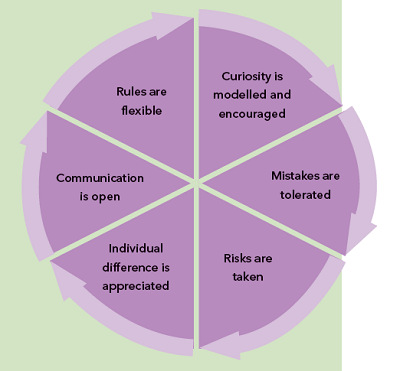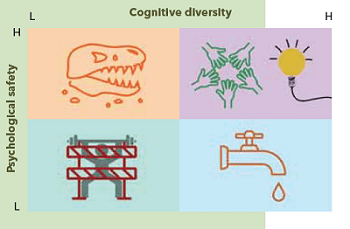You need exemplary leadership, confident teams, excellent communication and time for strategic thinking if you are to successfully innovate. Too much to ask? Siobhan Soraghan shows how it’s done.
Let’s start by defining innovation. Simply put, it’s nothing but solving problems and taking advantage of opportunities effectively. However, in an organisational setting, it’s not just about coming up with new and better ways of operating, but also about adapting to, and even anticipating, the change in your stakeholders’ needs. This can translate into changes in products, processes, the whole organisational model and even its raison d’être. In a world that’s volatile, uncertain, complex and ambiguous (VUCA), innovation is not an option – it’s essential for survival.
Without innovation, any organisation is subject to a natural phenomenon called strategic drift – the gradual falling away from the initial match with stakeholders’ needs. Even in a non-VUCA world there is natural evolution and change in the external environment. Therefore, drift is inevitable unless those running the organisation and its teams keep very much in tune with what is going on and respond with agility. For internal service teams, this is just as relevant – ‘out there’ can simply mean other parts of the organisation.
In a stable market, innovation may mean doing existing things faster and more cheaply. But this can lead to ignorance of shifts in stakeholders’ appetites. Typically, when the gap becomes clear, the reaction is to work harder doing the same things with greater intensity, while expecting different results.
What is really called for, at both a strategic level and the operational team level, is the ability to question what’s been held dear about the role of the team or organisation, asking John F Kennedy-style, “What do our stakeholders need from us now?”, rather than “What do we need from our stakeholders (so we can perfect doing our job the way we’ve become used to doing it)?”. It’s about seeing your own domain, whether that be the whole organisation or your team, with fresh eyes and reframing its strategic purpose.
It’s about recognising that historical ways of doing things can become comfort traps. The many processes designed to save time and make things run slickly can, in time, begin to hold you down like the many tiny ropes in Lilliput held down Gulliver. Humans are creatures of habit, so it’s natural for us to feel uncomfortable when familiar rituals are changed. Established teams develop norms, especially within large corporates, as they have evolved over some time. As a team leader, it helps to recognise that your people could experience considerable discomfort when asked to explore and adopt new methods.
You will be their champion when they are the ones generating innovation and will be leading the charge into the rest of the organisation. It’s your job to minimise, where possible, any resistance they may encounter.
To help with this, there is a positive process to consider: design thinking (see below). This iterative approach puts your ‘audience’ – that is, your customers, clients and stakeholders – at the centre of innovation. It means inviting them into the room, so to speak, in order that they can be asked about their needs and involved in the process. This engagement is key. As the team leader, your success in enticing these essential people to participate in the process is a hugely important part of enabling your team to succeed in their efforts to innovate. It is an ongoing journey – stakeholders are not always conscious of their needs and can find it hard to express them well, so be prepared for the possibility that your initial ideas may not quite hit the mark. Pay great attention to reactions, as therein can lie gold. Patience and curiosity are key.
Design thinking
1. Empathise
Learn about the audience for whom you’re designing
2. Define
Construct a point of view that is based on user needs and insights
3. Ideate
Brainstorm and come up with creative solutions
4. Prototype
Build a representation of one or more of your ideas to show others
5. Test
Return to your original user group and test your ideas for feedback
Second that emotion
Much ‘emotional labour’ is involved in leading an innovative team. You yourself need to be ahead of the change curve, having effectively dealt with your stress about important transitions. To lead convincingly, you need to wholeheartedly believe that the chosen route is possible. If you don’t, your team will sense your anxiety, magnifying any doubt or stress they may have. This very real effect is known as emotional contagion.
You must, therefore, prioritise your well-being. Know your emotional triggers and commit to regulating their impact. We know that in stressful times, threat activates our reptile brain, the amygdala. Unfortunately, this is not conducive to fresh thinking – the result is a knee-jerk firefighting mechanism, essential for survival in crisis.
To access our more sophisticated thinking capabilities, we need to step back and attain some degree of calm. When we develop the ability to emotionally regulate, we can access our more advanced capacity of thought, located in the neocortex. We then have a much better chance to see things from different perspectives, reframe our issues and innovate more effectively.
Regular periods away from the pressures of operational delivery allow valuable time to think strategically. Achieving a good balance and rhythm between operations and strategic thinking is a crucial responsibility for leaders of innovative teams. Key to this can be exercise, perhaps meditation, regular conversations with a mentor or coach, and quality down time.
Pick and choose
Another important role for the leader of innovative teams is to forge relationships with appropriate stakeholders – and to consciously and diplomatically reduce time spent on those who are no longer relevant. We naturally enjoy spending time with people we like. Those relationships can be hugely beneficial if they are key, but it’s also important to be proactive, positive political actors. In other words, however uncomfortable it may feel, have the courage to lean into and leverage those new connections that are crucial to helping a team’s innovations gain purchase.
As a leader you’ll also need to nurture the internal landscape within the team. Ideally, you want the kind of diversity that optimises innovation – a variety of cognitive styles and life experiences. For example, you’ll need the ‘Steady Eddies’ who build incrementally in a sure manner, as well as the mavericks who think out of the box; specialists as well as generalists; the ‘people’ people and those who are task-focused.
Hiring for this kind of diversity is essential, as is implementing sound foundational management practices, such as effective on-boarding of new recruits, good skills development plans, setting clear objectives, the provision of ongoing feedback, and conducting regular dialogue across the team.
For these practices to work well, psychological safety is a must (see below). As a team leader, this is largely down to you. Evidence shows it’s a key determinant of a team’s capacity to innovate. No pressure, then!

Looking good
So what does all this look like if you’re doing it well? You’ll be setting a clear context for the team with a meaningful purpose that you have passion for, translating the organisational strategy into language they can understand and relate to. Their failures will be seen as learning opportunities, and unintentional mistakes will be blame-free.
You’ll demonstrate humility by inviting participation, giving everyone a voice and actively listening. Diversity of opinion will be encouraged, and bad news shared as much as good. You’ll take a systems-thinking approach to problems so that complexity is not oversimplified – for example, root causes behind symptoms will be explored, assumptions surfaced and challenged by all respectfully, and interdependencies between issues explored. Successes will be clearly defined and rewarded. Team members will be encouraged to bring their whole selves to work. Importantly, you will protect the team from external flak.
Needless to say, if you’re getting all this right, you’re also building tremendous team resilience (see ‘The Innovation Potential Grid’ below). You will have a collaborative, innovative team that’s open to newcomers, with the robustness to engage in creative abrasion and the confidence to experiment, fail and learn fast – ultimately the sum will be greater than the parts.
Last but not least, you’ll have a mobilising personal vision for your role that motivates you to invest in healthy practices for regulating your energy and emotional state. You’ll be enjoying the journey and experiencing that, thankfully, good vibes are just as contagious as bad!
The Innovation Potential Grid
Get everything right and you should be aiming for the top right section of the Innovation Potential Grid (below) and succeed in avoiding:
- the bottom left of the grid, where potential stars are preoccupied by the need for self-preservation;
- the top left, where you’d find contented, perhaps insular guardians of the status quo; and
- the bottom right, where potential is constrained by distrust and energies wasted on unhelpful competition.

About the author
Siobhan Soraghan BSc MBA, Founder and Director, Active Insight, and host of the Innovation Network, a peer learning community of thoughtful professionals, keen to innovate products, processes and their organisation.
More support on business
Read our articles, eBooks, reports and guides on finance transformation
Finance transformation hubFinancial management eBooksCan't find what you're looking for?
The ICAEW Library can give you the right information from trustworthy, professional sources that aren't freely available online. Contact us for expert help with your enquiries and research.
